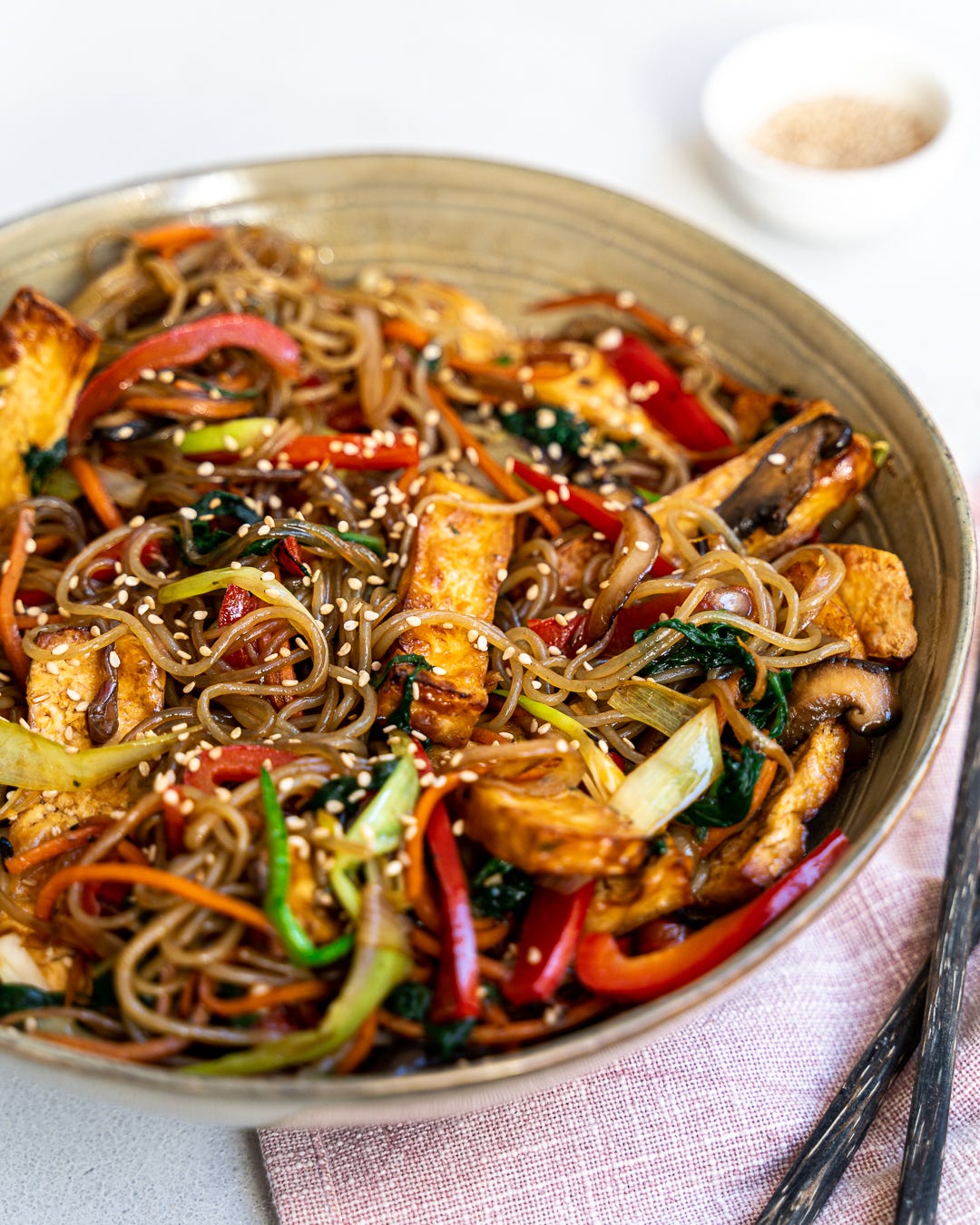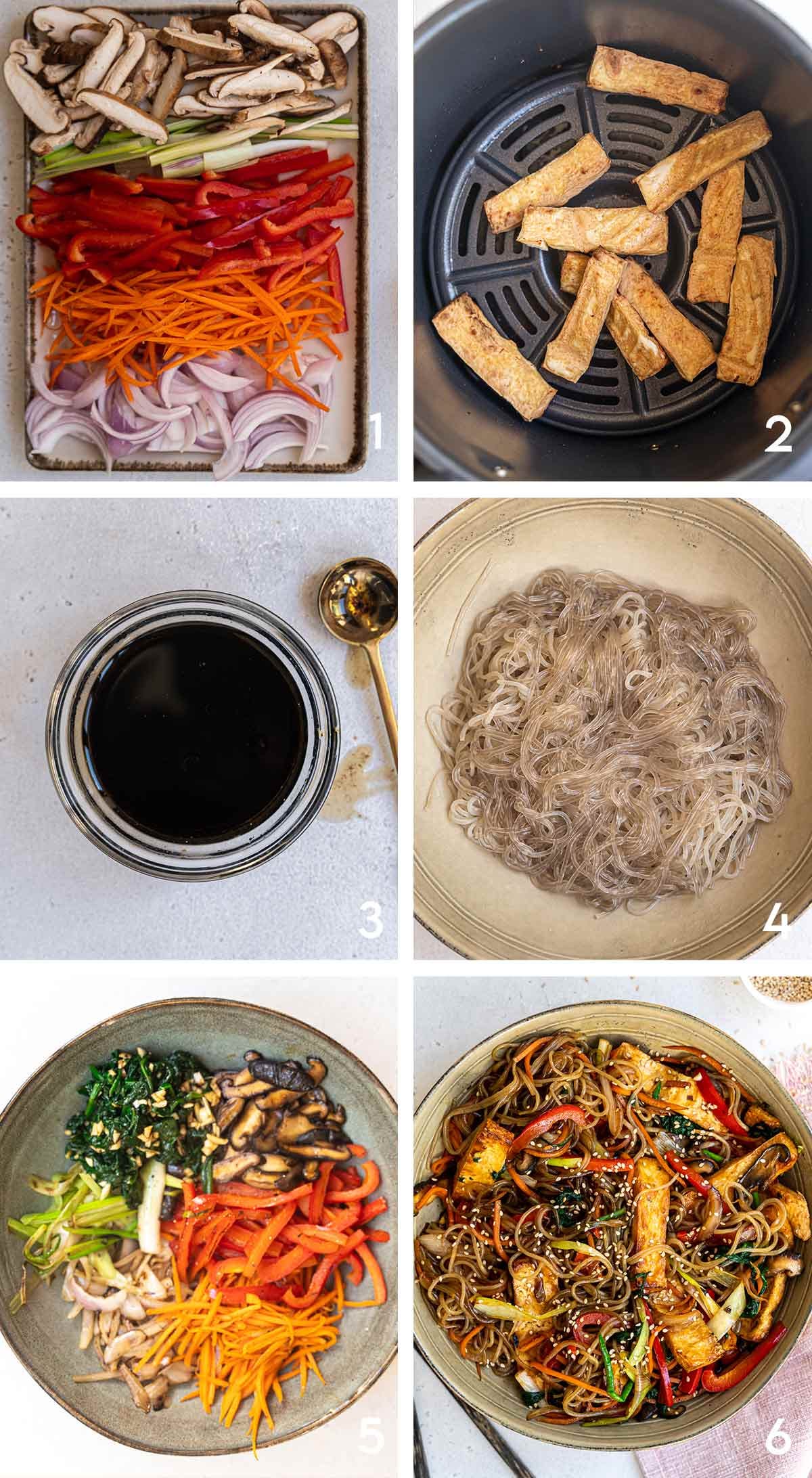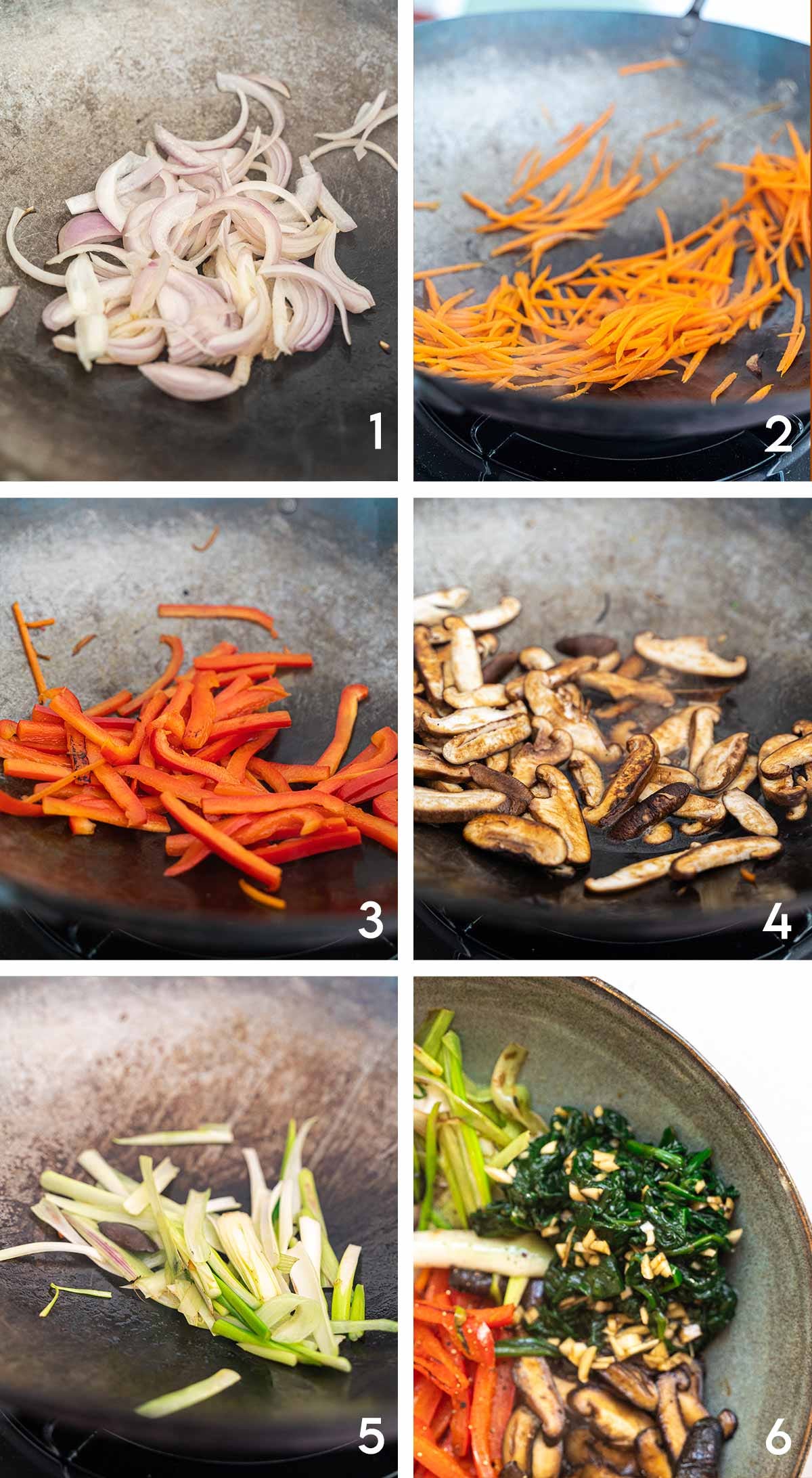Hi there! Happy Thursday 💚
For the second day of Veganuary, I want to share our amazing Vegan Japchae. While looking for the best recipes that I want to feature during this month, I realized we should definitely make Japchae way more often than we do. This chewy noodle dish is super flavorful and easy to prepare. This Korean meal consists of Sweet potato noodles served with stir-fried vegetables, crunchy tofu, and a delicious and rich sauce. Ready to try?
I love South Korean food, but the truth is that most of it is not vegan. One of our favorite restaurants at home is South Korean, but only a few options are suitable for vegans. We have the classic Bibimbap served with delicious Gochujang sauce, a tofu and vegetable coconut curry, and Japchae. Because of this, I tried this noodle dish that instantly became a favorite recipe that we started cooking at home.
Note that Japchae is traditionally made with meat and egg, but this is our vegan version of this lovely Korean meal featuring tofu.
Become a Paid Subscriber and get our weekly Veganuary Meal Plan starting from the 6th of January and instant access to all our exclusive content. Now 50% off our yearly subscription (only some spots left).
Ingredients
Sweet Potato Noodles or Korean Vermicelli. Made from sweet potato starch, you can find this type of noodles in Asian supermarkets or online. When dry, these chewy noodles have a greyish color. After boiling them in water for a couple of minutes, they have a really nice chewy texture that makes this dish unique. They are really similar to the cellophane noodles used to make Pad Woon Sen.
Shiitake Mushrooms. Dried or fresh shiitake mushrooms are a key ingredient when making Korean Japchae. They add umami and a great texture to this meal. If you are using dried shiitake mushrooms, they will need to be left in warm water for at least 30 minutes before being used in order to rehydrate the mushrooms.
Protein. Firm tofu has always been our favorite choice when making Asian-style noodles. For our Vegan Japchae, we air-fry the tofu while we cook the rest of the ingredients using our Ninja Air fryer. You can pan-fry or deep-fry the tofu as well.
Fresh veggies. For our vegetarian Japchae, we use carrots, red bell peppers, onions, spring onions, and spinach. We like to keep it simple, colorful, and flavourful. You can add other veggies such as shallots, green beans, pak choi, or broccoli.
Sweet Soy Sauce. This umami-rich sauce is made using simply three ingredients: tamari or soy sauce, sesame oil, and brown sugar.
Garlic. We love garlic flavor, so we use raw garlic for this recipe. You can cook it before adding it to the noodles.
Sesame seeds. A Korean Japchae is not complete without toasted sesame seeds added on top.
Step-by-Step Method
Prepare the vegetables for your Vegan Japchae by thinly slicing the shiitake mushrooms, spring onions, red pepper, carrots, and onion. Cook the spinach in boiling water for about 2 minutes or until wilted. Drain and reserve for later.
Cook the tofu. For this recipe, we air-fry the tofu cut into thin strips for about 12 minutes at 200C (400F). Before adding the tofu to the air fryer, a brush is used to add a little olive oil or coconut oil to the tofu strips. You can pan-fry the tofu or deep-fry it to make tofu puffs.
Prepare the Japchae sauce. Combine tamari, sesame oil, and maple syrup. You can use soy sauce or dark soy sauce, but note that the recipe won't be gluten-free. As well, if you prefer to use another sweetener, you can use sugar, brown sugar, or monk fruit.
Cook the sweet potato starch noodles. Bring a large pot of water to a boil. Add the noodles and cook following the packet instructions. Drain the water and reserve the noodles for later. To prevent the noodles from sticking, add a tablespoon of sesame oil and stir well.
Cook the vegetables. Korean Japchae is a fairly simple dish to make at home, but it requires some time as the vegetables need to be cooked separately. Korean food is all about the flavors, and if you cook the vegetables all at once, some flavors will overpower others. We like using our Wok or a large skillet for this recipe as each batch of veggies takes just 2-3 minutes. You can check a step-by-step method for cooking the vegetables below.
Add the noodles to a big serving bowl, and add the tofu, the cooked vegetables, and the Japchae sauce. Mix well until all the ingredients are combined and coated with the sauce; add some sesame seeds, adjust with salt and pepper, and serve.
Note: You can add chili paste or toasted sesame chili oil to add some spice to the dish.
Cooking the veggies separately: Our secret to the perfect Vegan Japchae
I love this part, and even if it takes a little longer, cooking your veggies one at a time when preparing your Japchae really makes a difference in the flavor of the dish, allowing all the veggies to develop a rich flavor without getting overpowered by another flavor.
Add some vegetable oil to the wok, heat over medium-high heat, and add the onion finely chopped. Cook for 2-3 minutes and transfer to a large mixing bowl or serving bowl.
Grease the wok again if needed, and add the finely chopped carrot. Cook for another 2-3 minutes and transfer to the plate with the onions.
Repeat the process for the red bell pepper.
Grease the pan now with a little sesame oil and add the shiitake together with a tablespoon of tamari, 1/2 teaspoon of sugar, and two tablespoons of water. Cook until most of the liquid is absorbed. Transfer to the plate with the rest of the vegetables.
Add the green onions, cook for 1 or 2 minutes, and transfer to the plate.
For the spinach, combine it with finely chopped or pressed garlic and a teaspoon of sesame oil. Mix well and add with the cooked vegetables.
Once you have all the veggies cooked, season generously with salt and pepper.
Download the whole recipe for quantities and instructions. Also, you can find more information about this recipe on the blog.
I hope you enjoy the second recipe of Veganuary 2025 and look forward to the upcoming ones! 😀
Love,
Laura.







This is great!!! 👍